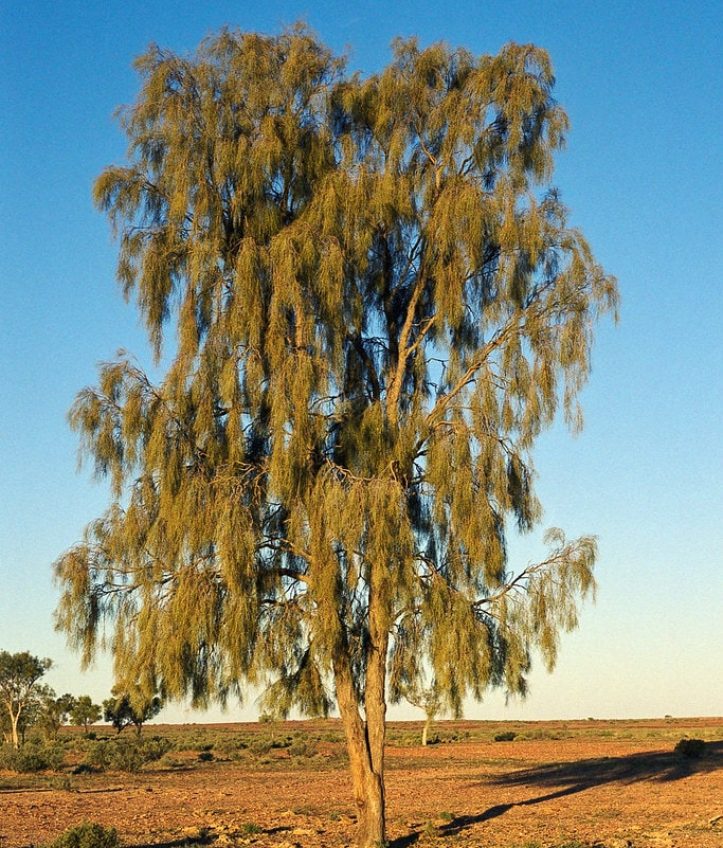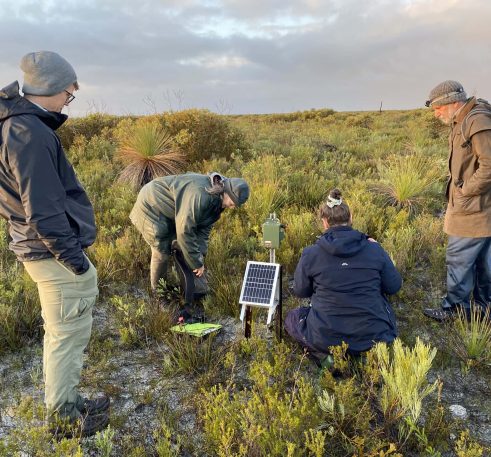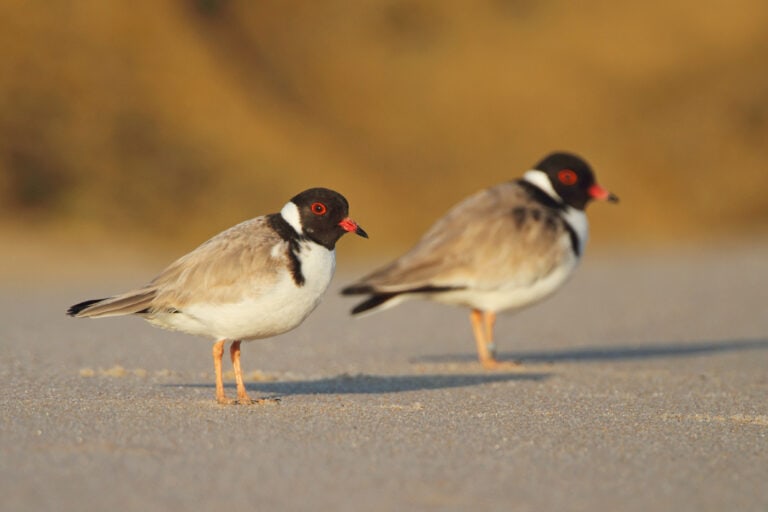Standardising survey guidelines for priority
threatened species monitoring

TERN is working with the Australian Government Department of Climate Change, Energy, the Environment and Water (DCCEEW) to design survey guidelines and recommendations for monitoring priority threatened species. This work contributes to monitoring targets under DCCEEW’s Threatened Species Action Plan 2022-2032.
The project forms an extension to a suite of related projects DCCEEW has underway with TERN, including the development of standardised monitoring protocols and field collection apps and data management systems for ecological field data and vertebrate pest data. It will also deliver software enhancements to the Threatened Species Index, a centralised platform for threatened species data collection and robust measures of change in the relative abundance of threatened species.
Data captured from surveys that follow the guidelines and recommendations for priority threatened species will be compatible with national biodiversity information standards, enabling rigorous data management. This will facilitate careful and considered data sharing with trusted sources to identify the necessity for additional monitoring or research needs, and adaptive management strategies, whilst maintaining the protection of sensitive data. In addition, data obtained will enable accurate reporting of species trajectories and broader environment reporting, such as the State of the Environment Report, and also be used to inform priorities for future investment in biodiversity conservation and threatened species recovery
Survey guidelines for best practice
The project will collate existing literature and knowledge to identify key biological and ecological information needed to guide the monitoring requirements of each of the Action Plan’s 110 priority threatened species (22 birds, 21 mammals, 9 fish, 6 frogs, 11 invertebrates, 11 reptiles and 30 plants). The priority threatened species were selected using a multi-criteria decision analysis process, and collectively represent Australia’s diverse land, sea and freshwater environments.
Related projects
Please download these project flyers to learn more about the projects TERN and DCCEEW are collaborating on to improve ecological monitoring standards.

The project will produce
- Literature overviews for 65 priority threatened species, identifying monitoring standards and techniques currently used by ecologists and practitioners.
- Literature reviews of selected priority threatened species.
- General survey guidelines for the 110 priority threatened species.
- Species-specific guidelines and recommendations for the priority threatened species in most need of urgent attention and/or standardisation across broad distributions.
Monitoring guidelines for 110 Priority threatened species
The Threatened Species Action Plan 2022-32, identifies 110 priority species. These species are listed below.
The first phase of the project involves preparation of literature overviews for selected species. The literature overviews are intended to provide a summary of the species under review, identifying known distributions, key resources and ecological requirements, as well as an overview of the known survey techniques used for monitoring. The literature overviews are currently being compiled and undergoing review. The literature overviews and are intended to be updated over time as new information becomes available.
The second phase of the project is also currently being undertaken. More in-depth literature reviews are being completed for 20 species selected by DCCEEW. Once drafted and made available to experts familiar with monitoring these species, work on the species-specific survey guidelines will commence.
Birds
- Australasian bittern Botaurus poiciloptilus
- Black-eared miner Manorina melanotis
- Carnaby’s black cockatoo Zanda latirostris
- Christmas Island goshawk Accipiter hiogaster natalis
- Eastern curlew Numenius madagascariensis
- Golden-shouldered parrot Psephotus chrysopterygius
- Hooded plover (eastern) Thinornis cucullatus cucullatus
- King Island brown thornbill Acanthiza pusilla magnirostris
- King Island scrubtit Acanthornis magna greeniana
- Malleefowl Leipoa ocellata
- Night parrot Pezoporus occidentalis
- Noisy scrub-bird Atrichornis clamosus
- Norfolk Island green parrot Cyanoramphus cookii
- Orange-bellied parrot Neophema chrysogaster
- Plains-wanderer Pedionomus torquatus
- Princess parrot Polytelis alexandrae
- Red goshawk Erythrotriorchis radiatus
- Red-tailed black cockatoo (SE) Calyptorhynchus banksii graptogyne
- Regent honeyeater Anthochaera phrygia
- Swift parrot Lathamus discolor
- Western ground parrot Pezoporus flaviventris
- White-throated grasswren Amytornis woodwardi
Mammals
- Australian sea-lion Neophoca cinerea
- Brush-tailed rock-wallaby Petrogale penicillata
- Central Rock-rat Zyzomys pedunculatus
- Chuditch Dasyurus geoffroii
- Eastern quoll Dasyurus viverrinus
- Gilbert’s potoroo Potorous gilbertii
- Greater bilby Macrotis lagotis
- Kangaroo Island echidna Tachyglossus aculeatus multiaculeatus
- Koala (Qld, NSW, ACT) Phascolarctos cinereus
- Leadbeater’s possum Gymnobelideus leadbeateri
- Mountain pygmy-possum Burramys parvus
- New Holland mouse Pseudomys novaehollandiae
- Northern brushtail possum Trichosurus vulpecula arnhemensis
- Northern hairy-nosed wombat Lasiorhinus krefftii
- Northern hopping-mouse Notomys aquilo
- Northern quoll Dasyurus hallucatus
- Numbat Myrmecobius fasciatus
- Quokka Setonix brachyurus
- Spectacled flying-fox Pteropus conspicillatus
- Southern bent-wing bat Miniopterus orianae bassanii
- Western ringtail possum Pseudocheirus occidentalis
Fish
- Freshwater sawfish Pristis pristis
- Grey nurse shark (eastern) Carcharias taurus
- Maugean skate Zearaja maugeana
- Murray hardyhead Craterocephalus fluviatilis
- Red handfish Thymichthys politus
- Redfin blue-eye Scaturiginichthys vermeilipinnis
- Stocky galaxias Galaxias tantangara
- Swan galaxias Galaxias fontanus
- White’s seahorse Hippocampus whitei
Frogs
- Growling grass frog Litoria raniformis
- Kroombit tinker frog Taudactylus pleione
- Mountain trog Philoria kundagungan
- Mountain-top nursery-frog Cophixalus monticola
- Southern corroboree frog Pseudophryne corroboree
- White-bellied frog Anstisia alba
Reptiles
- Arnhem Land gorges skink Bellatorias obiri
- Bellinger River snapping turtle Wollumbinia georgesi
- Canberra earless dragon Tympanocryptis lineata
- Collared delma Delma torquata
- Great desert skink Liopholis kintorei
- Green turtle Chelonia mydas
- Olive Ridley turtle Lepidochelys olivacea
- Pygmy blue-tongue lizard Tiliqua adelaidensis
- Short-nosed sea snake Aipysurus apraefrontalis
- Western Swamp turtle Pseudemydura umbrina
- Yinnietharra rock-dragon Ctenophorus yinnietharra
Invertebrates
- Ammonite snail Ammoniropa vigens
- Cauliflower soft coral Dendronephthya australis
- Eltham copper butterfly Paralucia pyrodiscus lucida
- Giant Gippsland earthworm Megascolides australis
- Glenelg freshwater mussel Hyridella glenelgensis
- Kangaroo Island assassin spider Zephyrarchaea austini
- Lord Howe Island phasmid Dryococelus australis
- Margaret River burrowing crayfish Engaewa pseudoreducta
- Mount Lidgbird charopid land snail Pseudocharopa ledgbirdi
- Pink underwing moth Phyllodes imperialis smithersi
- Tasmanian giant freshwater crayfish Astacopsis gouldis
Plants
- Adamson’s blown-grass Lachnagrostis adamsonii
- Angle-stemmed myrtle Gossia gonoclada
- Arckaringa daisy Olearia arckaringensis
- Border Ranges lined fern Antrophyum austroqueenslandicum
- Bulberin nut Macadamia jansenii
- Carrington Falls pomaderris Pomaderris walshii
- Davies’ waxflower Phebalium daviesii
- Eremophila subangustifolia
- Foote’s grevillea Grevillea calliantha
- Forked spyridium Spyridium furculentum
- Giant Andersonia Andersonia axilliflora
- Graveside leek-orchid Prasophyllum taphanyx
- Imlay mallee Eucalyptus imlayensis
- King blue-grass Dichanthium queenslandicum
- Lax leek orchid Prasophyllum laxum
- Little mountain palm Lepidorrhachis mooreana
- MacDonnell Ranges cycad Macrozamia macdonnellii
- Native guava Rhodomyrtus psidioides
- Pimelea cremnophila
- Pimelea venosa
- Scaly-butt mallee Eucalyptus leprophloia
- Small-flowered snottygobble Persoonia micranthera
- Smooth Davidson’s plum Davidsonia johnsonii
- Stiff groundsel Senecio behrianus
- Stirling Range dryandra Banksia montana
- Tangled wattle Acacia volubilis
- Waddy Acacia peuce
- Wollemi pine Wollemia nobilis
- Wongan eriostemon Philotheca wonganensis
- Woods Well spyridium Spyridium fontis-woodiib
Outcomes
- More consistent monitoring efforts
- Improved accuracy in tracking species population trajectories
- More accurate reporting on the state and trends of threatened species
- Better understasnding of the performance of conservation strategies and return on investment
Get involved
The current monitoring methods used by landholders, communities, First Nations peoples, the private sector, non-government organisations, regional NRM groups, post-graduate students, researchers and scientists working on the recovery of priority threatened species will be considered and integrated into the survey guidelines being developed. Experts from across the country will be able to provide input through workshop opportunities and close collaborations to guide the development of the guidelines using their knowledge and understanding of the species and experiences implementing monitoring survey techniques.
Please contact TERN if you would like to receive further information about upcoming opportunities, including an online workshop scheduled for the second half of 2023, to be involved and make a contribution.
Contact us







